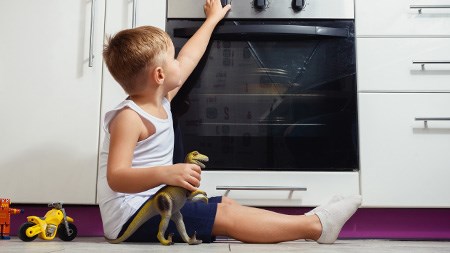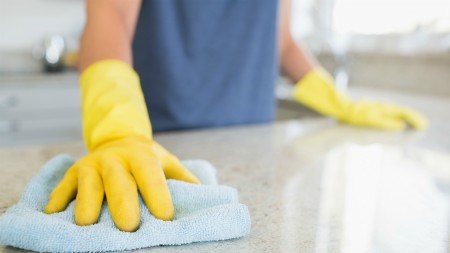Childproofing your home is essential to keep your baby safe. These tips will help protect your child from hazards in and around your house.
Raising a child is an exciting experience. It can also be stressful due to the many safety concerns involved. Before a child starts crawling, it’s relatively easy to keep track of your child and control what they do. However, when your child starts crawling, the nature of the game changes and you have to take steps to mitigate the risks posed by the immediate environment. This is commonly referred to as ‘child proofing’..
Childproofing a home can be relatively straightforward or complicated depending on the nature of the home. A good place to start is to get down on your hands and knees and look at the immediate environment from a baby’s point of view. What catches your eye? Is there anything which could fall on your child if it was pulled or pushed? Is there anything on the floor or on shelves which could be a choking hazard? Does any of your furniture have jagged corners or exposed nails? Are there areas which your child could potentially get stuck?
These are but a few of the questions which you need to ask before you let your child wander around your home. You will also have to re-asses your home as your child gets bigger and learns how to walk and climb. In order to facilitate your childproofing efforts, it’s best to focus on one room at a time, research the matter and consult with childproofing experts if necessary.
The following tips on childproofing your home should come in handy.
A baby proof kitchen
The kitchen poses multiple hazards to a young child so you may want to consider barring your child from entering this area entirely through the use of child safety gates. If you are comfortable to let your child roam the kitchen, consider the following:
- Remove any and all cleaning aids, detergents and poisons from cupboards and drawers which can be accessed by your child and lock them away in a cupboard which cannot be easily reached. There are numerous child safety mechanisms which can be attached to cupboards and drawers for this purpose. In line with this, when using any of the above, be sure to pack them away immediately after use.
- When using the stove, try to restrict usage to the back plates and make sure all pot and pan handles are turned away from where inquisitive little hands might be able to reach them. You might also want to consider installing an oven lock.
- Keep all sharp utensils (especially knives) and associated kitchenware out of reach and away from kitchen counter edges when in use. Again, child safety locks are arguably the best way to prevent access to such items.
Kid-friendly bathrooms:
Barring access to the bathroom isn’t always really viable so it’s important to make sure this room is child friendly.
- Medicine cabinets can pose a serious risk to children in bathrooms. It’s best to install a fixed medicine cabinet which can be locked. Free-standing medicine chests can fall onto children and any loose contents could easily be ingested. Even if your cabinet is locked, make sure all the medications and vitamins are stored in child proof containers and dispose of old and expired products.
- Be sure to keep all razors and razor blades well out of reach at all times.
- Toiletries such as shampoo and body wash may not seem like much of a risk but if ingested by a child can be hazardous. Items such as these should also be kept out of reach, preferably in a locked vanity or on a high shelf, well out of reach.
- Toilets and hot bathroom water can pose a risk. Over the years there have been numerous cases where children have drowned in toilets or have been burned by hot bathroom tap water. Toilet locks and anti-scalding devices are available for those concerned about such risks.
- If you have any electrical outlets in your bathroom for shavers or hair dryers, make sure you install outlet protectors and disconnect and pack away any accessories after use.
- Come bath time, never leave your child alone unsupervised. Children can drown very quickly in very little water.
Dining rooms, living rooms and bedrooms:
When considering these rooms, think about whether or not they really are suitable for your child. For example, although not necessarily dangerous, a formal dining room filled with expensive furniture, silverware, alcohol and precious antiques is not really a place for a child. As such, it’s probably best to bar entry to such a room with the use of a child safety gate until your child is older. Informal living rooms, lounges and bedrooms on the other hand typically make for great spaces within which your child can play and interact with you.
- If any stairs lead to these areas, be sure to fit safety gates at the bottom and top of the stairs.
- Secure heavy furniture and appliances such as bookcases and TV’s to a wall with the use of brackets or similar as such items can pose a real risk to small children if pulled over. It’s also a good idea to remove or place heavy items such as books on lower shelves.
- Generally speaking, curtains should be safe. Blinds however can pose a strangling hazard if they have looped cords so make sure any blinds you have are child safe. Cribs should also not be placed anywhere near blind cords.
- If sharp furniture corners are a concern, there are loads of edge and corner ‘bumper’ products on the market which can be used to prevent injury.
- Cover all electricity outlets with outlet covers when not in use.
- When your child starts climbing, you may need to move certain pieces of furniture away from windows.
- Windows can be extremely hazardous for children, particularly if they open up from raised elevations. There are numerous window locks and guards which have been designed specifically to keep children safe and are worth investigating if you think this poses a risk in your home.
- Make sure all toys and associated items in these rooms are child friendly.
Read more: Safety tips for kid's rooms
The garage, garden and pool:
It goes without saying that these areas pose numerous risks to young children.
- Your garage should be blocked off entirely by a door and safety gate.
- Do not leave your young child unsupervised in a garden as they could eat a toxic plant, berries or seeds or get stuck somewhere.
- Do not leave buckets of water or wading pools unattended.
- If you have a pool, make sure that it is enclosed by an appropriate fence and locked with a good gate. The same applies to Jacuzzis.
- Make sure your child cannot access driveways and roads at all times.
Lastly, keep in mind that small children need to be supervised at all times. You should also consider installing appropriate fire detection and prevention mechanisms such as smoke detectors and extinguishers throughout your house. A first aid kit is a must and a list of emergency contact numbers saved on your phone is also essential when there are young children around.
READ MORE: 9 Home safety rules every child should know
For more advice on how you can make your home a safer place for your child to roam freely browse the advice section on the Private Property website.



